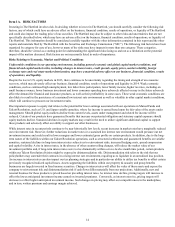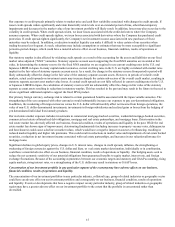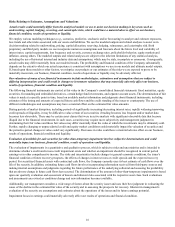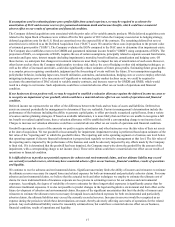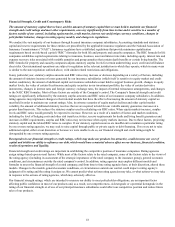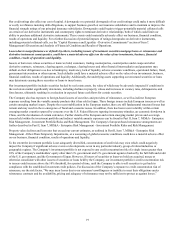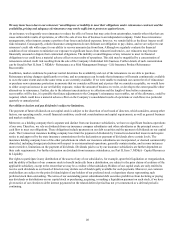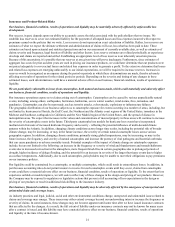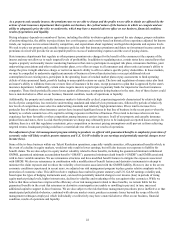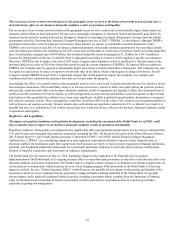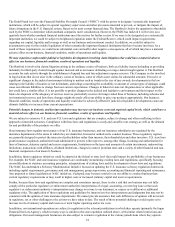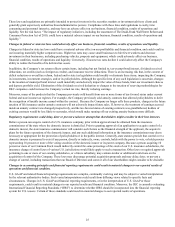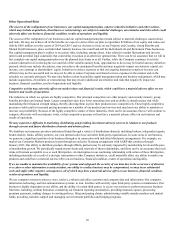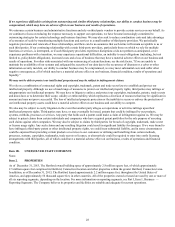The Hartford 2013 Annual Report Download - page 24
Download and view the complete annual report
Please find page 24 of the 2013 The Hartford annual report below. You can navigate through the pages in the report by either clicking on the pages listed below, or by using the keyword search tool below to find specific information within the annual report.24
The Dodd-Frank Act vests the Financial Stability Oversight Council (“FSOC”) with the power to designate “systemically important”
institutions, which will be subject to special regulatory supervision and other provisions intended to prevent, or mitigate the impact of,
future disruptions in the U.S. financial system. Based on its most current financial data, The Hartford is below the quantitative thresholds
used by the FSOC to determine which nonbank companies merit consideration. However, the FSOC has indicted it will review on a
quarterly basis whether nonbank financial institutions meet the metrics for further review. If we were to be designated as a systemically
important institution, we could be subject to heightened regulation under the Federal Reserve, which could impact requirements
regarding our capital, liquidity and leverage as well as our business and investment conduct. In addition, we could be subject to
assessments to pay for the orderly liquidation of other systemically important financial institutions that have become insolvent. As a
result of these requirements, we could incur substantial costs and suffer other negative consequences, all of which may have a material
adverse effect on our business, financial condition, results of operations and liquidity.
We may experience unfavorable judicial or legislative developments involving claim litigation that could have a material adverse
effect on our business, financial condition, results of operations and liquidity.
The Hartford is involved in claims litigation arising in the ordinary course of business, both as a liability insurer defending or providing
indemnity for third-party claims brought against insureds and as an insurer defending coverage claims brought against it. The Hartford
accounts for such activity through the establishment of unpaid loss and loss adjustment expense reserves. The Company is also involved
in legal actions that do not arise in the ordinary course of business, some of which assert claims for substantial amounts. Pervasive or
significant changes in the judicial environment relating to matters such as trends in the size of jury awards, developments in the law
relating to the liability of insurers or tort defendants, and rulings concerning the availability or amount of certain types of damages could
cause our ultimate liabilities to change from our current expectations. Changes in federal or state tort litigation laws or other applicable
law could have a similar effect. It is not possible to predict changes in the judicial and legislative environment and their impact on the
future development of the adequacy of our loss reserves, particularly reserves for longer-tailed lines of business, including asbestos and
environmental reserves, and how those changes might adversely affect our ability to price our products appropriately. Our business,
financial condition, results of operations and liquidity could also be adversely affected if judicial or legislative developments cause our
ultimate liabilities to increase from current expectations.
Potential changes in domestic and foreign regulation may increase our business costs and required capital levels, which could have a
material adverse effect on our business, financial condition, results of operations and liquidity.
We are subject to extensive U.S. and non-U.S. laws and regulations that are complex, subject to change and often conflicting in their
approach or intended outcomes. Compliance with these laws and regulations is costly and can affect our strategy, as well as the demand
for and profitability of the products we offer.
State insurance laws regulate most aspects of our U.S. insurance businesses, and our insurance subsidiaries are regulated by the
insurance departments of the states in which they are domiciled, licensed or authorized to conduct business. These regulatory regimes
are generally designed to protect the interests of policyholders rather than insurers, their shareholders and other investors. U.S. state laws
grant insurance regulatory authorities broad administrative powers with respect to, among other things, licensing and authorization for
lines of business, statutory capital and reserve requirements, limitations on the types and amounts of certain investments, underwriting
limitations, transactions with affiliates, dividend limitations, changes in control, premium rates and a variety of other financial and non-
financial components of an insurer's business.
In addition, future regulatory initiatives could be adopted at the federal or state level that could impact the profitability of our businesses.
For example, the NAIC and state insurance regulators are continually reexamining existing laws and regulations, specifically focusing
on modifications to statutory accounting principles, interpretations of existing laws and the development of new laws and regulations.
The NAIC has undertaken a Solvency Modernization Initiative focused on updating the U.S. insurance solvency regulation framework,
including capital requirements, governance and risk management, group supervision, accounting and financial reporting and reinsurance.
Any proposed or future legislation or NAIC initiatives, if adopted, may be more restrictive on our ability to conduct business than
current regulatory requirements or may result in higher costs or increased statutory capital and reserve requirements.
Further, because these laws and regulations are complex and sometimes inexact, there is also a risk that our business may not fully
comply with a particular regulator's or enforcement authority's interpretation of a legal, accounting, or reserving issue or that such
regulator’s or enforcement authority’s interpretation may change over time to our detriment, or expose us to different or additional
regulatory risks. The application of these regulations and guidelines by insurers involves interpretations and judgments that may not be
consistent with the opinion of state insurance departments. We cannot provide assurance that such differences of opinion will not result
in regulatory, tax or other challenges to the actions we have taken to date. The result of those potential challenges could require us to
increase levels of statutory capital and reserves or incur higher operating and/or tax costs.
In addition, our international operations are subject to regulation in the relevant jurisdictions in which they operate (primarily the Japan
Financial Services Agency), which in many ways is similar to the state regulation outlined above, with similar related restrictions and
obligations. Our asset management businesses are also subject to extensive regulation in the various jurisdictions where they operate.


